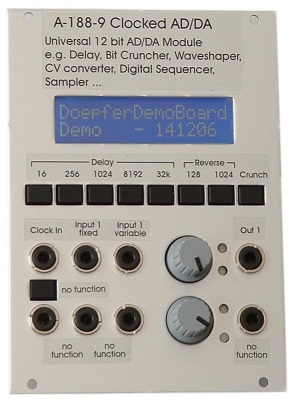 "The picture shows the first prototype of the universal AD/DA module. In principle this module is nothing a clocked AD/processor/memory/DA chain. AD means Analog-to-Digital converter, i.e. the analog voltage (audio or control voltage) is converted into a digital format with 12 bit resolution. The digital signal is processed or delayed by a microcontroller with a large memory and then converted back into the analog voltage by an Digital-to-Analog converter. The prototype has two AD inputs (with attenuator), two clock inputs, 2 pairs of LEDs, and two DA outputs as for certain functions (e.g. voltage controlled bit crusher or waveshaper) two voltages are necessary. The mode is selected by means of 8 buttons and a LC display.
"The picture shows the first prototype of the universal AD/DA module. In principle this module is nothing a clocked AD/processor/memory/DA chain. AD means Analog-to-Digital converter, i.e. the analog voltage (audio or control voltage) is converted into a digital format with 12 bit resolution. The digital signal is processed or delayed by a microcontroller with a large memory and then converted back into the analog voltage by an Digital-to-Analog converter. The prototype has two AD inputs (with attenuator), two clock inputs, 2 pairs of LEDs, and two DA outputs as for certain functions (e.g. voltage controlled bit crusher or waveshaper) two voltages are necessary. The mode is selected by means of 8 buttons and a LC display.Examples for processing (without using the delay memory): bit crusher, bit exchanger, audio and CV waveshaper, Hz/V-to-V/Oct converter and vice versa, and many more. In principle everything that can be realized by calculating the AD output using certain rules and then converting the result into a voltage by the DA converter.
Examples for processing (with delay memory): clocked audio/CV delay with adjustable memory length between 128 (e.g. for flanger or Karplus/Strong) up to one million (for long audio delays many seconds or even minutes), digital sequencer (i.e. recording/storing/plaing back a CV).
The clock input is used to trigger AD/DA conversion. For audio signal processing the clock has to be in the audio range or beyond (e.g. from a VCO or high speed VCO). For CV processing the clock can be slower.
The final module(s) will probably look different. The prototype is used as a kind of defelopment tool to find out which function are useful. As soon as we made our first experiences and have found out what is possible we will probably start a poll in the A-100 Yahoo group how many different modules with which kind of controls should be released after all. The prototype will be probably shown at the NAMM booth of Analogue Haven in January."
via sequencer.de





































12 bits is not enough.
ReplyDeleteI like 19 bits.
Or 23 bits.
Or even 17 bits, if cornered.
12 is crap... isnt standard MIDI in the range of 14bits for just the basic CC resolution?
ReplyDeletebut i think doepfer has a MIDI-CV converter that is also limited to 12 bits
crazy germans! ACHTUNG!
I question the perceptual acuity of anyone who complains about the converter resolution of such a cool module. Digital filth in a modular format is most welcome in any design, and I'm of the type who embraces "less is more" when it comes to a digital audio path.
ReplyDeleteBasic CC resolution is 7 bits.
meatlog: if you're usin it to record sequences, 12 bits only gives you 4096 voltages. If it's bipolar, it's half that on each side, which isn't enough to replay sequences in tune.
ReplyDeleteSure, it has it's uses, but it could have more uses if it had more bits (even better if it had a bitcrusher output).